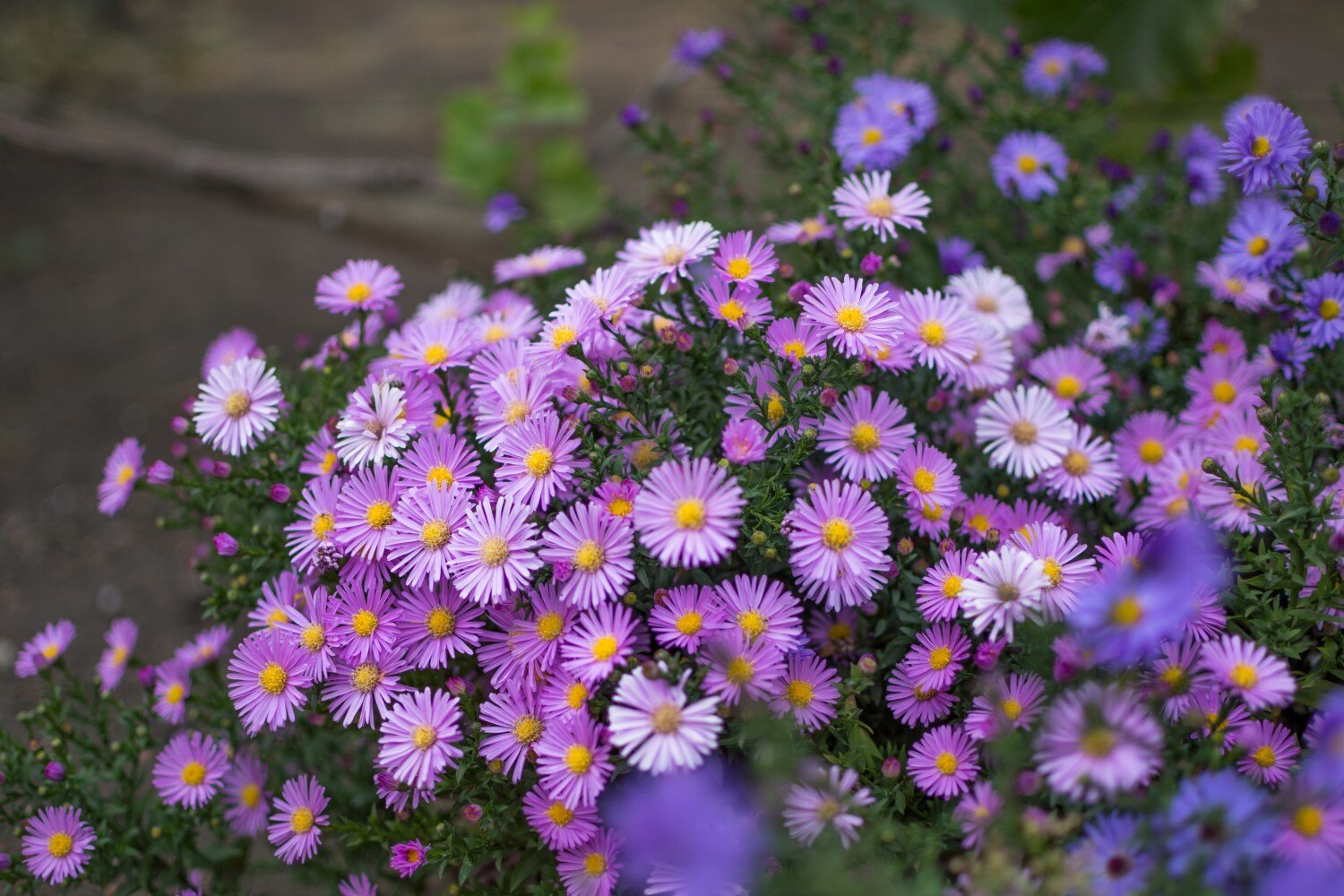
Michaelmas Daisy, also known as Aster or Symphyotrichum, is a stunning flowering plant that has captured the hearts of garden enthusiasts all over the world. With its vibrant colors and delicate petals, the Michaelmas Daisy adds a touch of elegance and beauty to any garden or landscape.
But there’s more to this fascinating plant than meets the eye. In this article, we’ll delve into 20 astounding facts about Michaelmas Daisy that will leave you amazed and intrigued. From its rich history and symbolism to its incredible range of varieties and medicinal properties, there’s no shortage of reasons to appreciate the wonders of this remarkable plant.
So, if you’re ready to uncover the secrets and marvels of Michaelmas Daisy, let’s dive in and explore the world of this extraordinary flowering plant!
Key Takeaways:
- Michaelmas Daisy, also known as Aster amellus, is a stunning perennial flower native to Europe and the Mediterranean. It symbolizes love, patience, and elegance, making it a popular choice for gardens and floral arrangements.
- With over 250 species and a wide range of colors, Michaelmas Daisy blooms late in the season, attracting butterflies and bees. It’s easy to grow, has potential medicinal properties, and is celebrated in festivals across Europe.
Michaelmas Daisy is native to Europe and the Mediterranean region.
Originating from Europe and the Mediterranean, Michaelmas Daisy has been cultivated and admired for centuries due to its captivating beauty.
The flower gets its name from the Christian feast of St. Michael the Archangel.
Legend has it that Michaelmas Daisy blooms around the feast day of St. Michael the Archangel, which falls on September 29th each year.
Michaelmas Daisy is often associated with love, patience, and elegance.
Symbolizing love, patience, and elegance, Michaelmas Daisy is a popular choice for bridal bouquets, floral arrangements, and garden displays.
There are over 250 different species of Michaelmas Daisy.
This diverse plant family is made up of over 250 species, each with its own unique characteristics and colors.
Michaelmas Daisy blooms in a wide range of colors, including purple, pink, blue, and white.
From deep purples and vibrant pinks to serene blues and pure whites, Michaelmas Daisy offers a kaleidoscope of colors to brighten any garden or flower bed.
The flowers resemble daisies with their iconic yellow centers and delicate petals.
With their classic daisy-like appearance, Michaelmas Daisy flowers feature a prominent yellow center, also known as a disc floret, surrounded by delicate petals known as ray florets.
Michaelmas Daisy is a popular choice for attracting butterflies and bees to the garden.
The nectar-rich flowers of Michaelmas Daisy serve as a magnet for butterflies, bees, and other pollinators, making it an excellent addition to any pollinator garden.
This resilient flower can tolerate a wide range of growing conditions.
From full sun to partial shade and well-drained soil, Michaelmas Daisy can adapt to various environmental conditions, making it a versatile flowering plant.
Michaelmas Daisy blooms late in the season, providing color and beauty in the fall.
While many flowers fade as summer comes to an end, Michaelmas Daisy shines brightly, adding a burst of color to gardens and landscapes during the autumn months.
The plant’s foliage is known for its attractive dark green color and slender shape.
Even when the flowers are not in bloom, Michaelmas Daisy’s foliage remains visually appealing, thanks to its lush dark green leaves that gracefully complement the surrounding landscape.
Michaelmas Daisy is often used in traditional medicine for its potential medicinal properties.
Throughout history, various cultures have used Michaelmas Daisy for its potential medicinal benefits, such as treating respiratory ailments, digestive issues, and even promoting skin health.
The flowers of Michaelmas Daisy can be dried and used in decorative crafts.
Whether creating wreaths, potpourri, or floral arrangements, dried Michaelmas Daisy flowers add a touch of natural beauty to any handmade craft project.
Michaelmas Daisy can be easily propagated through division or stem cuttings.
Expanding your Michaelmas Daisy collection is as simple as dividing the plant or taking stem cuttings, making it a favorite among gardeners who enjoy sharing their garden treasures with others.
The name “aster” comes from the Latin word for “star,” inspired by the flower’s star-like shape.
Derived from the Latin word for “star,” the name “aster” perfectly describes the flower’s stunning star-like shape, which adds a celestial touch to any garden or floral arrangement.
Michaelmas Daisy is often featured in art and literature as a symbol of beauty and grace.
From classic paintings to poetry and literature, Michaelmas Daisy has been a source of inspiration for artists and writers who seek to convey the timeless beauty and grace of nature.
Some species of Michaelmas Daisy can reach a height of up to 6 feet.
While the average height of Michaelmas Daisy varies between species, some varieties can tower up to an impressive 6 feet, creating a stunning vertical accent in gardens and landscapes.
Michaelmas Daisy is an excellent choice for cutting gardens and floral arrangements.
Thanks to its long-lasting blooms and vibrant colors, Michaelmas Daisy is a popular choice among floral enthusiasts and gardeners who love to create stunning bouquets and arrangements.
This perennial flower is known for its ability to attract beneficial insects like ladybugs and lacewings.
In addition to butterflies and bees, Michaelmas Daisy also attracts beneficial insects, such as ladybugs and lacewings, which help control garden pests naturally.
Michaelmas Daisy is a favorite among gardeners who want to extend the blooming season in their gardens.
With its late-season blooms, Michaelmas Daisy beautifully complements other fall-flowering plants, extending the beauty and color in the garden well into the autumn months.
Michaelmas Daisy is celebrated with festivals and events in many European countries.
Across various European countries, Michaelmas Daisy is honored and celebrated with festivals and events, where the flower takes center stage and showcases its irresistible charm.
From its symbolic meanings to its stunning beauty and versatility, Michaelmas Daisy continues to captivate and amaze flower enthusiasts around the world. Whether in gardens, floral arrangements, or cultural celebrations, this remarkable flower brings joy, color, and a touch of elegance wherever it blooms.
Conclusion
In conclusion, Michaelmas Daisy, with its vibrant blooms and hardy nature, is truly an astounding flower. Its versatility, beauty, and ability to attract pollinators make it a popular choice for gardens and landscapes. Whether you’re a gardening enthusiast or simply appreciate the marvels of nature, Michaelmas Daisy is a plant that should not be overlooked. With its rich history, medicinal properties, and stunning variety of colors, this perennial is sure to add a touch of elegance and charm to any outdoor space.So, why not consider adding Michaelmas Daisy to your garden? As you can see from the fascinating facts we’ve explored, this flower has so much to offer. From its ability to symbolize hope and love, to its ability to thrive in different climates, Michaelmas Daisy is a true gem in the world of plants.So go ahead, embrace the beauty and wonder of Michaelmas Daisy and let it brighten up your garden for years to come!
FAQs
1. What is the meaning behind the name “Michaelmas Daisy”?
Michaelmas Daisy gets its name from the Christian festival of Michaelmas, which falls on September 29th. The flower blooms around this time, and it is said to symbolize the triumph of good over evil.
2. Is Michaelmas Daisy easy to grow?
Yes, Michaelmas Daisy is a relatively easy plant to grow. It thrives in well-drained soil and prefers full sun or partial shade. It is also quite tolerant of different soil types and can withstand varying weather conditions.
3. Can I grow Michaelmas Daisy in containers?
Yes, Michaelmas Daisy can be grown in containers. Just make sure the containers have adequate drainage holes and use a good quality potting mix. Remember to water the plants regularly and provide enough sunlight for them to thrive.
4. Does Michaelmas Daisy attract pollinators?
Absolutely! Michaelmas Daisy is known to attract a wide range of pollinators, including bees, butterflies, and hoverflies. Its nectar-rich flowers provide a valuable food source for these beneficial insects.
5. Are there different varieties of Michaelmas Daisy?
Yes, there are numerous varieties of Michaelmas Daisy available, offering a wide range of colors and sizes. Some popular varieties include ‘September Ruby‘ with its deep red blooms, ‘Snow Cushion’ with its white flowers, and ‘Autumn Fire’ with its orange and yellow petals.
6. Can I use Michaelmas Daisy for medicinal purposes?
Yes, Michaelmas Daisy has been traditionally used for its medicinal properties. It is believed to have anti-inflammatory and immune-boosting properties. However, it’s important to consult a healthcare professional before using any plant for medicinal purposes.
If you've enjoyed learning about the enchanting Michaelmas Daisy, why not continue your exploration of beautiful blooms? Delve into the captivating world of Aster flowers and uncover their unique characteristics. From their vibrant colors to their ability to attract pollinators, Aster flowers are sure to pique your curiosity. So, keep your love for nature blooming and discover more fascinating facts about these stunning flowers!
Was this page helpful?
Our commitment to delivering trustworthy and engaging content is at the heart of what we do. Each fact on our site is contributed by real users like you, bringing a wealth of diverse insights and information. To ensure the highest standards of accuracy and reliability, our dedicated editors meticulously review each submission. This process guarantees that the facts we share are not only fascinating but also credible. Trust in our commitment to quality and authenticity as you explore and learn with us.


